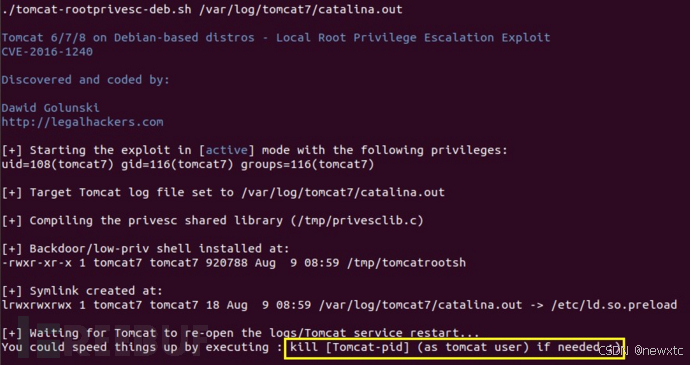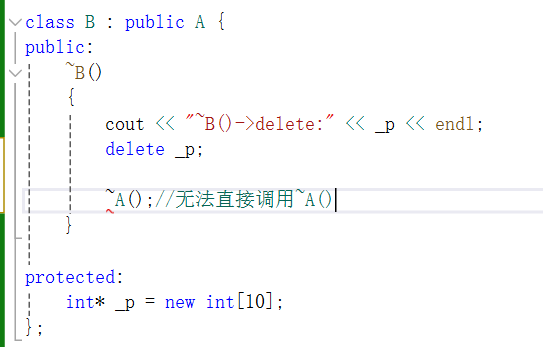一、项目介绍
项目总结
1.按下空格键小鸟上升,不按小鸟下落
2.搭建小鸟需要穿过的管道
3.管道自动左移和创建
4.小鸟撞到管道游戏结束
知识储备
1.C语言
2.数据结构-链表
3.Ncurses库
4.信号机制

二、Ncurses库介绍
Ncurses是最早的System V Release 4.0 (SVr4)中 curses的一个克隆和升级。这是一个可自由配置的库,完全兼容旧版本curses。
Ncurses构成了一个工作在底层终端代码之上的封装,并向用户提供了一个灵活高效的API(Application Programming Interface 应用程序接口)。它提供了创建窗口界面,移动光标,产生颜色,处理键盘按键等功能。使程序员编写应用程序不需要关心那些底层的终端操作。
简而言之,它是一个管理应用程序在字符终端显示的函数库。
Ncurses库函数
注:安装命令:sudo apt-get install libncurses5-dev
为了能够使用Ncurses库,必须在源程序中将#include<curses.h>包括进来,而且在编译的需要与它链接起来.
在gcc中可以使用参数-lncurses进行编译.
1. initscr(void);
是curses模式的入口。将终端屏幕初始化为curses模式,为当前屏幕和相关的数据结构分配内存。
2. int endwin(void);
是curses模式的出口,退出curses模式,释放curses子系统和相关数据结构占用的内存。
3. int curs_set(int visibility);
设置光标是否可见,visibility:0(不可见),1(可见)
4. int move(int new_y, int new_x);
将光标移动到new_y所指定的行和new_x所指定的列
5. int addch(const chtype char);
在当前光标位置添加字符
6. int refresh(void);
刷新物理屏幕。将获取的内容显示到显示器上。
7. int keypad(WINDOW *window_ptr, bool key_on);
允许使用功能键。exp:keypad(stdscr,1);//允许使用功能按键
8. int getch(void);
读取键盘输入的一个字符
9. chtype inch(void);
获取当前光标位置的字符。
注:curses有自己的字符类型chtype,使用时强制类型转换为char
10. int start_color(void);
启动color机制,初始化当前终端支持的所有颜色
11. int init_pair(short pair_number, short foreground, short background);
配置颜色对
COLOR_BLACK 黑色 COLOR_MAGENTA 品红色
COLOR_RED 红色 COLOR_CYAN 青色
COLOR_GREEN 绿色 COLOR_WHITE 白色
COLOR_YELLOW 黄色 COLOR_BLUE 蓝色
12. int COLOR_PAIR(int pair_number);
设置颜色属性,设置完颜色对,可以通过COLOR_PAIR实现
13. int attron(chtype attribute);
启用属性设置
14. int attroff(chtype attribute);
关闭属性设置
Ncurses库安装
安装命令:sudo apt-get install libncurses5-dev
注:为了能够使用Ncurses库,必须在源程序中将#include<curses.h>包括进来,而且在编译的需要与它链接起来. 在gcc中可以使用参数-lncurses进行编译。
编译gcc surses.c -o curses -lncurses
三、信号
在Linux中,软中断信号(signal,简称为信号)是在软件层次上对中断的一种模拟,用来通
知进程发生了异步事件。内核可以因为内部事件而给进程发送信号,通知进程发生了某个事件。
信号响应的方式:
1.忽略信号,即对信号不做任何处理;
2.捕捉信号,即信号发生时执行用户自定义的信号处理函数。
3.执行缺省操作,Linux对每种信号都规定了默认操作。

设置信号相应方式-signal
#include <unistd.h>
#include <signal.h>
typedef void (*sighandler_t)(int);
sighandler_t signal(int signum, sighandler_t handler);
成功时返回原先的信号处理函数,失败时返回SIG_ERR
signum:指明了所要处理的信号类型
handler:描述了与信号关联的动作
SIG_DFL代表缺省方式; SIG_IGN 代表忽略信号;
指定的信号处理函数代表捕捉方式
signal函数-示例
// 头文件省略
void handler (int signo) {
printf(“HELLO!\n”);
}
int main() {
signal(SIGINT, handler);
while ( 1 ) ;
return 0;
}
设置定时器
struct itimerval {
struct timeval it_interval; /* 计时器重新启动的间歇值 */
struct timeval it_value; /* 计时器安装后首次启动的初
}; 始值,之后就没有用 */
struct timeval {
long tv_sec; /* 秒 */
long tv_usec; /* 微妙*/
};计时器的实现
int setitimer(int which, const struct itimerval *value,struct itimerval *ovalue)
参数:
which:间歇计时器类型,
ITIMER_REAL //数值为0,发送的信号是SIGALRM。
struct itimerval *value:将value指向的结构体设为计时器的当前值,
struct itimerval *ovalue:保存计时器原有值。一般设置为NULL。
返回值: 成功返回0。失败返回-1。四、项目功能实现
项目安排
阶段1:初始化工作,小鸟功能实现

阶段2:管道功能实现
1.创建链表
2.显示管道
3.清除管道
4.移动管道
阶段3:完善代码,进行项目总结
1.判断游戏结束:小鸟与管道碰到
2.循环创建管道
3.为管道和小鸟添加色彩
代码功能
#include <stdio.h>
#include <curses.h>
#include <signal.h>
#include <sys/time.h>
#include <stdlib.h>
#define BIRD '@'
#define BLANK ' '
#define PIPE '+'
/*定义关于管道的结构体*/
typedef struct Pipe{
int x;//列坐标
int y;//横坐标
struct Pipe *next;
}Pipe_node, *Pipe_list;
Pipe_list head, tail;
void creat_list();//创建链表
void show_pipe();//显示管道
void clear_pipe();//清除管道
void move_pipe();//移动管道
int bird_y, bird_x;//小鸟坐标
void show_bird();//显示小鸟
void clear_bird();//清除小鸟
void move_bird();//移动小鸟
void init_curses();//curses库初始化
int set_timer(int ms_t);//设置定时器--ms
void handler(int sig);//信号处理函数
int main(int argc, const char *argv[])
{
bird_y = 15;//行
bird_x = 10;//列
init_curses();
signal(SIGALRM, handler);
set_timer(500);//500ms
srand(time(0));//随机种子
creat_list();
show_pipe();
show_bird();
move_bird();
return 0;
}
void init_curses()//curses库初始化
{
initscr();//进入curses模式
curs_set(0);//禁止光标显示
noecho();//禁止输入字符显示
keypad(stdscr,1);//启动功能按键
start_color();//启动颜色机制
init_pair(1,COLOR_WHITE, COLOR_RED);//小鸟颜色设置
init_pair(2,COLOR_WHITE, COLOR_GREEN);//管道颜色设置
}
int set_timer(int ms_t)//设置定时器--ms
{
struct itimerval timer;
long t_sec,t_usec;
int ret;
t_sec = ms_t / 1000; //s
t_usec = (ms_t % 1000) * 1000;//us
timer.it_value.tv_sec = t_sec;
timer.it_value.tv_usec = t_usec;//首次启动定时值
timer.it_interval.tv_sec = t_sec;
timer.it_interval.tv_usec = t_usec;//定时时间间隔
ret = setitimer(ITIMER_REAL, &timer, NULL);
return ret;
}
void handler(int sig)
{
Pipe_list p, new;
int i,j;
/*小鸟下落*/
clear_bird();
bird_y++;
show_bird();
/*游戏结束判断*/
if((char)inch() == PIPE)
{
set_timer(0);
endwin();
exit(1);
}
p = head->next;
if(p->x == 0)
{
head->next = p->next;
for(i = p->x; i < p->x+10; i++)
{
/*上半部分管道*/
for(j=0; j<p->y; j++)
{
move(j,i);
addch(BLANK);
}
/*下半部分管道创建*/
for(j = p->y+5; j < 25; j++)
{
move(j,i);
addch(BLANK);
}
refresh();
}
free(p);
new = (Pipe_list)malloc(sizeof(Pipe_node));
new->x = tail->x + 20;
new->y = rand() % 11 + 5;
new->next = NULL;
tail->next = new;
tail = new;
}
/*管道移动*/
clear_pipe();
move_pipe();
show_pipe();
}
void show_bird()//显示小鸟
{
attron(COLOR_PAIR(1));
move(bird_y,bird_x);
addch(BIRD);
refresh();
attroff(COLOR_PAIR(1));
}
void clear_bird()//清除小鸟
{
move(bird_y,bird_x);
addch(BLANK);
refresh();
}
void move_bird()//移动小鸟
{
char key;
while(1)
{
key = getch();
if(key == ' ')
{
clear_bird();
bird_y--;
show_bird();
/*游戏结束判断*/
if((char)inch() == PIPE)
{
set_timer(0);
endwin();
exit(1);
}
}
}
}
void creat_list()//创建链表
{
int i;
Pipe_list p, new;
head = (Pipe_list)malloc(sizeof(Pipe_node));
head->next = NULL;
p = head;
for(i = 0; i < 5; i++)
{
new = (Pipe_list)malloc(sizeof(Pipe_node));
new->x = (i + 1) * 20;
new->y = rand() % 11 + 5; // (5-15行)
new->next = NULL;
p->next = new;
p = new;
}
tail = p;
}
void show_pipe()//显示管道
{
Pipe_list p;
int i,j;
p = head->next;
attron(COLOR_PAIR(2));
while(p)
{
for(i = p->x; i < p->x+10; i++)
{
/*上半部分管道*/
for(j=0; j<p->y; j++)
{
move(j,i);
addch(PIPE);
}
/*下半部分管道创建*/
for(j = p->y+5; j < 25; j++)
{
move(j,i);
addch(PIPE);
}
}
refresh();
p = p->next;
}
attroff(COLOR_PAIR(2));
}
void clear_pipe()//清除管道
{
Pipe_list p;
int i,j;
p = head->next;
while(p)
{
for(i = p->x; i < p->x+10; i++)
{
/*上半部分管道*/
for(j=0; j<p->y; j++)
{
move(j,i);
addch(BLANK);
}
/*下半部分管道创建*/
for(j = p->y+5; j < 25; j++)
{
move(j,i);
addch(BLANK);
}
}
refresh();
p = p->next;
}
}
void move_pipe()//移动管道
{
Pipe_list p;
p = head->next;
while(p)
{
p->x--;
p = p->next;
}
}

















